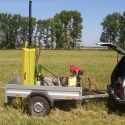15 Dec 2011
Progress in Wheat, Sunflower, and Sugar Beet Cultivation in Russia
V. Nosov, S. Ivanova
During most of the 1990s, Russian agriculture experienced a dramatic loss of capital and all the key indicators of agricultural profitability and productivity deteriorated. However, after devaluation of the ruble in 1998, Russian agriculture, especially its crop production sector, has grown steadily. The restructuring has allowed important organizational changes to emerge and strengthen, particularly within the corporate-farm segment. In this new situation, entrepreneurs appear interested in investing in new machinery, fertilizers, quality seeds, and professional consultation in order to improve their profitability potential due to more intensive crop production.
The emergence of large commercial operations, called agroholdings, has been one of the most drastic changes in Russian agriculture. Agro-holdings may be owned by either Russian or foreign managing companies. They form a production chain from growing the crops to processing/storage and sales. They now dominate cereals, sugar beet, and sunflower production.
Currently, there are three types of agricultural producers in Russia: 1) agricultural enterprises are joint stock companies, and the most advanced are subsidiaries of agro-holdings; 2) commercial farmers; and 3) subsistence farmers, or households. ROSSTAT (2009) reports that 76% of the area under wheat in 2007 was cultivated by agricultural enterprises. For sunflower and sugar beet in 2008, agricultural enterprises accounted for 65% and 88%, respectively. The remainder of the area is cultivated by farmers and, to a lesser extent, by subsistence farms. Russia’s major cereal crop is wheat, sunflower is a major oil crop, and sugar beet is the only sugar crop. Of the total 76.9 million (M) ha cropped in 2008, wheat occupied 35% of the area in the country, sunflower 8%, and sugar beet 1%. On average during the last 18 years, wheat area increased by 1% annually, sunflower by as much as 6% per year, but sugar beet acreage has decreased by 3% yearly (Figure 1).
Among these three crops, major progress has taken place in sugar beet cultivation over the last 5 to10 years. Sugar beet yield declined from 22.1 t/ha in 1990 to less than 15 t/ha at the end of 1990s, after the collapse of the USSR. Since then, yields have more than doubled to 35.4 t/ha in 2008 (Figure 2). A concentration of sugar beet cultivation in the most advanced and profitable agricultural enterprises with the best crop management explains these positive developments.
Data in Table 1 show that mineral fertilizer application to sugar beet has increased considerably.
In wheat, moderate progress has been achieved in management over recent years. The average yield was 2.1 t/ha in 1990, but poor management after the collapse of the USSR reduced it to a low of 1.0 t/ha in 1998. Poor crop management at that time led to low yields in all crops. However, wheat yields have since recovered and now average 2.4 t/ha (2008). Data on mineral fertilizer use in wheat indicates a slight improvement over the recent past (Table 1).
Similarly, sunflower yields declined to 0.7 t/ha by the end of the 1990s from a peak harvest of 1.3 t/ha in 1990. Data from 2008 indicate a recovery to 1.2 t/ha. In contrast to wheat and sugar beet, there has been a very small increase in fertilizer use for this crop as gains in production have simply been achieved through area expansion at the expense of other crops (Table 1).
It is important to note that in recent years the fertilized area increased noticeably for all crops. Unfortunately, country statistics on fertilizer use by crop are collected only from agricultural enterprises, and not all of them submit data to ROSSTAT. Whereas only 36% of the sunflower area in agricultural enterprises received fertilizers in 2008, 56% and 91% of the area planted to wheat and sugar beet, respectively, were fertilized. Taking into consideration the available fertilizer statistics for agricultural enterprises and the total crop acreage in the country in 2008, reported data may represent the fertilizer use for about 85% of sugar beet, 68% of wheat, and only 55% of sunflower production area.
IPNI has developed the AgriStats software (IPNI, unpublished data) that is intended to project fertilizer use by crop in a long-term perspective. The input data include estimates of the attainable crop yield and the average fertilizer application rates to achieve this attainable yield. The most realistic growth rate of crop planting area and the potential area that could be expected to receive fertilizer nutrients in the future are also estimated.
Based on recent research field experiments conducted in various soil-climatic zones of Russia (Sandukhadze et al., 2007; Kalichkin et al., 2008; Tsirulev, 2008; Vasyukov and Tsygankov, 2008; Lugantsev, et al., 2008; Zhivotovskaya, et al., 2007), we estimate average attainable yields of wheat as 4.5 t/ha, sunflower as 2.6 t/ha, and sugar beet as 46.0 t/ha (Table 2). IPNI defines attainable yieldas productivity achieved by a modern variety in farmer fields with current best anagement and ample (non-limiting) nutrient supply. Attainable yield is not influenced by economics, but shifts according to the regional growing environment and technological advances.
Thus, there is a large yield potential in both sunflower and wheat, but the actual yield of sugar beet is closer to our attainable yield estimation. The estimated fertilizer application rates (kg N-P2O5-K2O/ha) needed for the attainable yields are: 90-45-45 in wheat, 40-60-30 in sunflower, and 130-150-130 in sugar beet. Therefore, nutrient management of wheat, and especially sunflower, should be a serious concern in Russia. Fertilizer use in sugar beet needs to be improved too, particularly P and K application.
It is estimated that the attainable fertilized area for wheat may reach 80% for N and 70% for both P and K. The attainable fertilized area (%N/%P/%K) for sunflower and sugar beet is projected as: 90/90/70 and 100/100/100, respectively.
During 2003-2007, the profitability of sunflower cultivation was the highest of the three crops, fluctuating between 36% and 103% return on investment in production.
Wheat and sugar beet were less profitable, with ranges of 16 to 57% and 8 to 28%, respectively (ROSSTAT, 2009). Mironov (2008) reported that the cost of sugar production from sugar beet (i.e. sugar beet cultivation plus processing) in Russia was about 77 to 88% of wholesale sugar prices in 2003-2006 and reached 100 to 101% in 2007-2008. This is an indication that the sugar beet industry has encountered serious difficulties.
According to our estimates, wheat cropping area could increase to about 30.9 M ha by 2027, assuming that Russia will be an important exporter of wheat grain in the future. Sunflower and sugar beet area are projected to increase slightly by 2027 to 6.3 M ha and 1.0 M ha, respectively, based mainly on domestic consumption of vegetable oil and sugar.
Currently, Russia has two internal drivers to boost agricultural production. They are substitution of imported agricultural products (sugar, livestock husbandry products, and milk), and emerging opportunities to increase export of cereals, particularly wheat. Domestic agricultural producers are also able to take advantage of currency devaluation in Russia due to the recent global financial crisis and any related increases in prices of imported agricultural commodities. The Russian federal government stimulates crop production through minimum purchase prices of grain (wheat, barley, rye, and maize), fixed domestic prices on mineral fertilizers, development of animal husbandry, subsidized credits, and decreased taxes. During the last 2 years, the Russian grain market has gained the spotlight as officials are increasingly aware of apparent competitive advantages.
In 2007/08, grain production reached 108 M t of grains – the highest over the past 18 years. Russia ranked third in world wheat exports in 2008. Export of grain and flour is estimated at 20 M t for the 2008/09 season, or US$5 billion. This is another record in terms of value, which is comparable with other widespread foreign-trade operations such as wood and lumber (US$7.3 billion in 2008), and weapons (US$8 billion).
However, grain exports could be larger. During the first 6 months of 2008, prohibitive export taxes of 30 to 40% were in effect. Great volumes of Russian grain can’t reach global markets because of infrastructure problems such as transport vehicle shortages and insufficient elevators and grain port terminals. Russia’s other problem is its traditional reliance on export of low value feed grains, which is a symptom of producers’ reliance on inferior seed stocks and insufficient ability to access long-term grain storage facilities. In March 2009, the government addressed these problems through the formation of the United Grain Company (UGC), which reorganized all main state assets and also privately-owned facilities.
The recent financial crisis has found prices and volumes of raw material deliveries from Russia on the decline, but grain exports can increase in comparison since the country has first-rate arable areas under cereals that are primed for yield intensification through the adoption of knowledge-based technologies.




